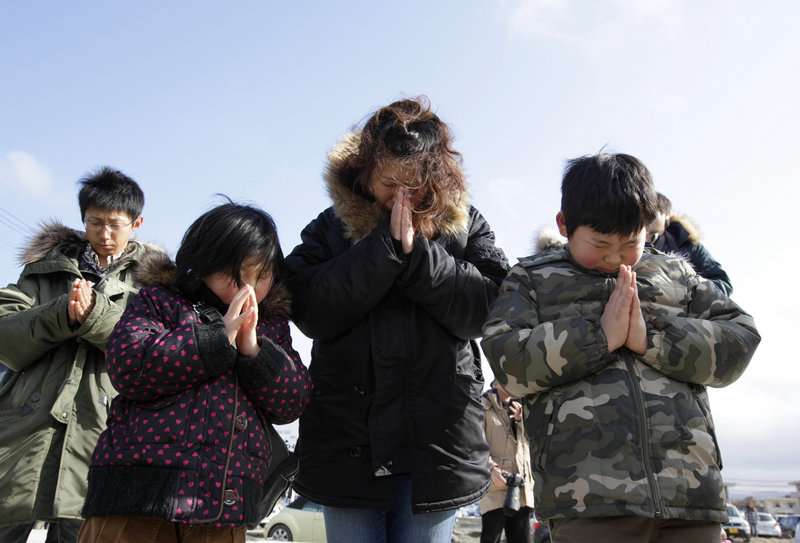RIKUZENTAKATA, Japan – For 70-year-old Toshiko Murakami, memories of the terrifying earthquake and tsunami that destroyed much of her seaside town and swept away her sister brought fresh tears Sunday, exactly a year after the disaster.
“My sister is still missing so I can’t find peace within myself,” she said before attending a ceremony in Rikuzentaka marking the anniversary of the March 11, 2011, disaster that killed more than 19,000 people and unleashed the world’s worst nuclear crisis in a quarter century.
Across Japan, people paused at 2:46 p.m. — the moment the magnitude-9.0 quake struck a year ago — for moments of silence, prayer and reflection about the enormous losses suffered and monumental tasks ahead.
Japan must rebuild dozens of ravaged coastal communities, shut down the crippled Fukushima Dai-ichi nuclear power plant and decontaminate radiated land so it is inhabitable again.
These are huge burdens on a country already straining under the weight of an aging, shrinking population, bulging national debt and an economy that’s been stagnant for 20 years.
Prime Minister Yoshihiko Noda reminded the Japanese people that they have overcome many disasters and difficulties in the past and pledged to rebuild the nation so it will be “reborn as an even better place.”
“Our predecessors who brought prosperity to Japan have repeatedly risen up from crises, every time becoming stronger,” Noda said at a ceremony at the National Theater attended by the emperor and empress.
Later, he told a news conference he hoped to see the disaster-hit areas fully rebuilt when “babies born on the day of the disasters turn 10 years old.”
The earthquake was the strongest recorded in Japan’s history, and set off a tsunami that swelled to more than 65 feet in some spots along the northeastern coast, destroying tens of thousands of homes and causing widespread destruction.
Some 325,000 people are still in temporary housing. Much of the debris along the tsunami-ravaged coast has been gathered into massive piles, but only 6 percent has been disposed of through incineration.
Little rebuilding has begun. Many towns are still finalizing reconstruction plans, some of which involve moving residential areas to higher, safer ground — an ambitious, costly project. Bureaucratic delays in coordination between the central government and local officials have also slowed rebuilding efforts.
In Rikuzentakata, which lost 1,691 residents out of its pre-quake population of 24,246, a siren sounded at 2:46 p.m. and a Buddhist priest in a purple robe rang a huge bell at a temple overlooking a barren area where houses once stood.
At the same moment in the seaside town of Onagawa, people facing the ocean pressed their hands together in silent prayer.
Memorial services continued into the night. In Ishinomaki, survivors lit some 2,000 candles to mourn the victims.
Send questions/comments to the editors.



Success. Please wait for the page to reload. If the page does not reload within 5 seconds, please refresh the page.
Enter your email and password to access comments.
Hi, to comment on stories you must . This profile is in addition to your subscription and website login.
Already have a commenting profile? .
Invalid username/password.
Please check your email to confirm and complete your registration.
Only subscribers are eligible to post comments. Please subscribe or login first for digital access. Here’s why.
Use the form below to reset your password. When you've submitted your account email, we will send an email with a reset code.